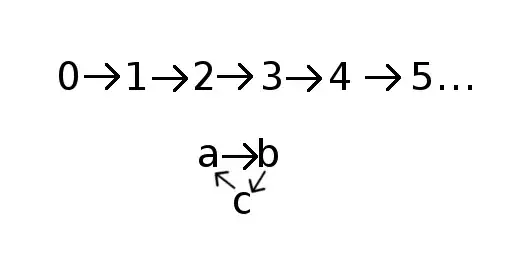If there is a circle of other symbols next to the infinite row of known natural numbers, doesn't this also fit all the requirements?
No. The structure indicated in your diagram violates the axiom of induction:
$$\forall P\subset N:[0\in P \land \forall a\in P: S(a)\in P \implies P=N]$$
This axiom rules out the possibility of set $N$ being comprised of two or more disconnected parts, as in your diagram.
To prove this, we need only the following Peano Axioms:
$0\in N$
$S:N\to N$
Suppose we have $X$, as in your diagram, such that:
$X \subset N\space\space$ (in this case, we have $X=\{a, b,c \}$)
$X\ne \emptyset$
$0\notin X$
$\forall x\in X:\neg \exists y\in N:[y\notin X\land S(y)=x]$
Let $X'=N\setminus X$
It can then be shown that:
$$X'\subset N \land [0\in X' \land \forall x\in X': S(x)\in X'\land \exists x\in N: x\notin X']$$
Generalizing...
$$\exists P\subset N : [0\in P \land \forall x\in P: S(x)\in P\land \exists x\in N: x\notin P]]$$
Or equivalently, we have the negation of the induction principle:
$$\neg\forall P\subset N:[0\in P \land \forall a\in P: S(a)\in P \implies P=N]$$
So are there multiple unequal sets of natural numbers?
If you have two structures $(N,S,0)$ and $(N',S',0')$ that satisfy the 5 Peano Axioms, they can be shown to be essentially identical (order isomorphic). There would exist a bijection $f$ such that:
$f: N\to N'$
$f(0)=0'$
$\forall a \in N: f(S(a))=S'(f(a))$
EDIT:
See my formal proof in DC Proof format (149 lines). There I prove that no non-empty, proper subset $X$ of $N$, like your $\{a,b,c\}$, can be "disconnected" from $N\setminus X$ as you have indicated in your diagram.
